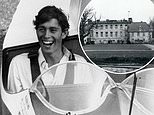
Both Charles and Andrew were sent to Gordonstoun, a tough boarding school on the remote, windswept north coast of Scotland that their father, Prince Philip, had been to. For Charles, it was another attempt to toughen him up so that he would be fit to be heir to the throne.
There, the sensitive youth would have to endure freezing temperatures. The classrooms were unheated and, in the belief that fresh air was good for you, the dormitory windows were left wide open while the boys slept, winter and summer.
Charles was assigned to Windmill Lodge, a long, narrow, stone-and-timber building with an asbestos roof and bare wooden floors. It was a temporary building supplied by the RAF which had never been replaced. There were 14 hard wooden beds to a dorm and bare lightbulbs hung from the ceiling.
Charles’s bed was under a window and in winter, he often woke to find his bedcovers encrusted with frost or even snow. When it rained, he would have to gather up his bedding and sleep on the floor in the centre of the room. Each day there was a pre-dawn run through the countryside — shirtless and in shorts, even when it snowed — followed by an icy shower.
‘Charles was a very polite, sweet boy — always incredibly thoughtful and kind, interested in art and music,’ the Queen’s cousin and confidante Margaret Rhodes said. ‘But his father interpreted this as weakness, and the Queen believed he knew what was best.
Charles was assigned to Windmill Lodge, a long, narrow, stone-and-timber building with an asbestos roof and bare wooden floors. Pictured: Prince Phillip (left), Charles (centre) and family friend Captain Iain Tennant (right)
Charles’s bed was under a window and in winter, he often woke to find his bedcovers encrusted with frost or even snow. Pictured: Prince Charles and Iain Tennant on his first day at Gordonstoun
Each day there was a pre-dawn run through the countryside — shirtless and in shorts, even when it snowed – followed by an icy shower. Pictured: A Gordonstoun schoolroom
‘Gordonstoun was supposed to “make a man out of him”, although I never really understood what that meant.’
Charles himself had wanted to go to Charterhouse, where the few friends he made at Cheam were headed. But he did not have a say. Gordonstoun was supposed to draw him out of his shy and reticent disposition. He would become more self-assertive. And, of course, Philip had been happy there.
But Philip had been an obscure foreign prince, not heir to the throne, and anyone who befriended him would not be seen as a boot-licking sycophant. When Charles walked down corridors, he would be greeted with loud sucking sounds.
And there was bullying. Once, after taking a shower, the 13-year-old Prince was pounced on, tied up and shoved into a wicker laundry basket, which was hoisted on a hook on the wall and blasted with freezing water.
His tormentors left him hanging there, naked and shivering, for half an hour until a staff member heard his plaintive cries. At night he would be pummelled in the darkness with pillows, shoes and fists until he dreaded going to bed.
The headmaster was a sadist who encouraged the older boys to pick on the younger ones, extorting money and food from them. After the housemasters had gone to bed it was a free-for-all. The custom was to haze new boys by taking a pair of pliers to the flesh and twisting until the skin tore. The worst of it occurred at Windmill Lodge and Prince Charles got the worst of the worst. Having been told not to pick on him, the boys enjoyed it all the more.
It was also open season on the rugby field, with boys boasting that they had punched the future King of England. On one occasion he ended up with a broken nose. Despite what his father had tried to teach him, Charles did not put up a fight.
Nor did he complain about the bullying, for fear that it would get worse. He sought solace in long walks in the countryside or seeking refuge in the art room, but this hardly helped. He was shunned.
Gordonstoun (pictured) was supposed to draw him out of his shy and reticent disposition. He would become more self-assertive. And, of course, Philip had been happy there
The headmaster was a sadist who encouraged the older boys to pick on the younger ones, extorting money and food from them. Pictured: Prince Charles (centre) arrives with his father Prince Philip (left) and Iain Tennant (right) on his first day at Gordonstoun
Charles sought solace in long walks in the countryside or seeking refuge in the art room. Pictured: Prince Charles meets two of the school’s top students, head boy, Peter Paice (left) and head boy of Windmill Lodge, Dougal McKenzie (right)
One schoolmate said: ‘How can you treat a boy as just an ordinary chap when his mother’s portrait is on the coins you spend in the school shop, on the stamps you use to post your letters home, when a detective trails him wherever he goes?
‘Most boys tend to fight shy of friendship with Charles. The result is that he is very lonely. It is this loneliness, rather than the school’s toughness, which must be hardest on him.’ Another contemporary said: ‘Charles was crushingly lonely for most of his time there. The wonder is that he survived with his sanity intact.’
Getting off campus did not help either. On a school trip to the Isle of Lewis, he was spotted by a crowd and sought sanctuary in a bar. When asked what he wanted to drink, he remembered he on
…. to be continued
Read full article at the Original Source
Copyright for syndicated content belongs to the linked Source : Daily Mail – https://www.dailymail.co.uk/news/article-12447035/New-book-reveals-young-Andrew-proposed-16-year-old-asked-run-away-Gretna-Green-historian-lifts-lid-sibling-rivalry-Charles.html?ns_mchannel=rss&ns_campaign=1490&ito=1490

